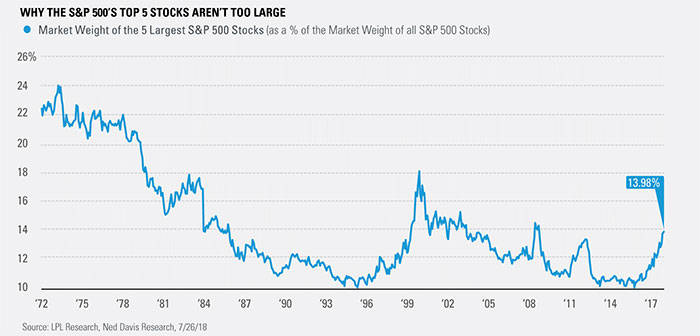The bears never run out of things to worry about. No matter what the news is, the bears say it’s bad.
A recent argument from the bears is that the gains in the market this year are due to just a few stocks. The FAANG stocks (Facebook, Apple, Amazon, Netflix and Alphabet, parent of Google) are supposedly responsible for the gains in major indexes.
But that’s not true.
As the chart below shows, the S&P 500 Index is less concentrated than average.

(Source: LPL Research)
The chart shows the impact of the five largest stocks on the index. Now, the top five stocks in the S&P 500 account for 13.98% of the total index. That’s below the 46-year average of 14.33%.
When a small number of stocks account for most of the index, that is a sign of a possible top. That’s exactly what happened in 1999. Just a few internet stocks moved the index, while most stocks began falling in 1998.
This time is different. Now, most stocks are moving in line with the index. That’s the sign of a healthy trend. And, in this case, the trend is up.
The bears, of course, disagree, but other indicators confirm a bullish outlook as well.
The price action, for example, is bullish since major indexes are above their long-term moving averages. Technical analysts define an uptrend as times when prices are above those moving averages.
Momentum indicators, like my Peak Velocity indicator, confirm the uptrend.
Fundamentals are a reason for concern. Market indexes are overvalued and vulnerable to a sell-off. But that’s true for most of the past 20 years.
News is also a cause for concern. A crisis in the Middle East could trigger a bear market, for example. But geopolitical crises are unpredictable and unlikely.
For now, the weight of the evidence remains on the side of the bulls.
Regards,

Michael Carr, CMT
Editor, Peak Velocity Trader




